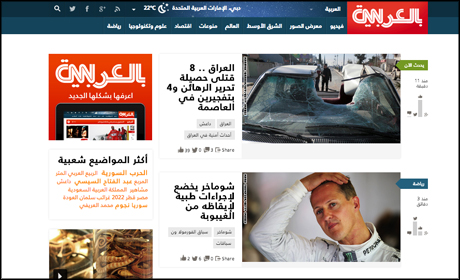The redesign, CNN's first responsive site, features newsfeed-style streaming of stories and a much bigger emphasis on images and social interaction.
Peter Bale, vice president and general manager of digital at CNN International, told Journalism.co.uk that the site received "unusually high" traffic from Twitter in the Arab world – more than 15 per cent of overall traffic – and particularly from Saudi Arabia.
He also explained it was a market that responded "incredibly strongly" to pictures, which in the new design have quadrupled in size.
"The way the pictures run border-to-border makes it a very rich experience," he said. "That combines particularly well on mobile with the continuous scroll."

Credit: Screenshot from CNNArabic.com
The redesigned platform revolves around a Facebook-style central 'newsfeed' containing a constant steam of around 40 stories including breaking news, features and trending topics.
One of the benefits of using such a familiar feature, said Bale, is that the site is "very instantly accessible".
However, he is quick to point out that the newsfeed is curated by journalists rather than determined by an algorithm, with the aim of surfacing only the highest-quality content.
One of the challenges CNN's development team faced was in creating "a real focus on the Arabic language and its particular characteristics in storytelling," Bale said.
"Arabic is a beautiful language but it is difficult to make legible on screens," Bale explained.
"There's a very big tradition of Arabic typography, so making it the site legible, modern and elegant was very important to us."
He also noted that the editorial team had quickly had to become much better at photo editing due to the the heavier focus on images, as well as the challenges posed by ensuring ads worked responsively.
"Everybody is learning, including us still, about how to deliver high-impact advertising on smaller screens," he said.
However, from a business point of view, the Middle East's burgeoning mobile internet market was one of the main driving points behind the redesign, he said.
"In the Gulf Cooperation Council alone there are 196 million SIM cards - that's two per person," Bale explained.
Speaking just a week since the redesign, he said it was too soon to tell whether it was having an impact on mobile traffic to CNN Arabic.
However, he said that even before the redesign, around a third of traffic to CNN Arabic came from mobile devices – something he predicts will only keep on growing.
And in the future, Bale said the organisation would be looking at how applicable some of the design principles behind CNN Arabic would be to its portfolio of other sites, with a new version of CNN International in the pipeline.
Free daily newsletter
If you like our news and feature articles, you can sign up to receive our free daily (Mon-Fri) email newsletter (mobile friendly).
Related articles
- What do audiences need from climate journalism?
- Alireza Haji Hosseini, director of CNN Academy, on simulated news training
- UNESCO-ICFJ report: three quarters of women journalists experience online violence
- CNN embarks on three-year digital project to cover gender inequality worldwide
- Amanpour: 'authoritarianism is creeping westward where it has no business belonging'









